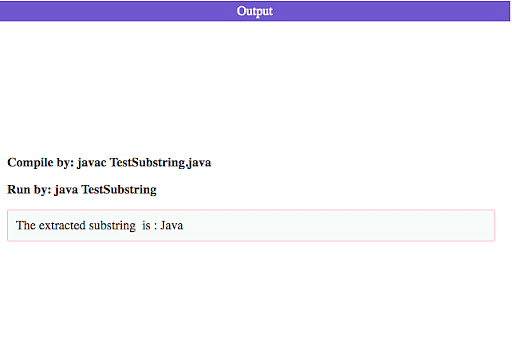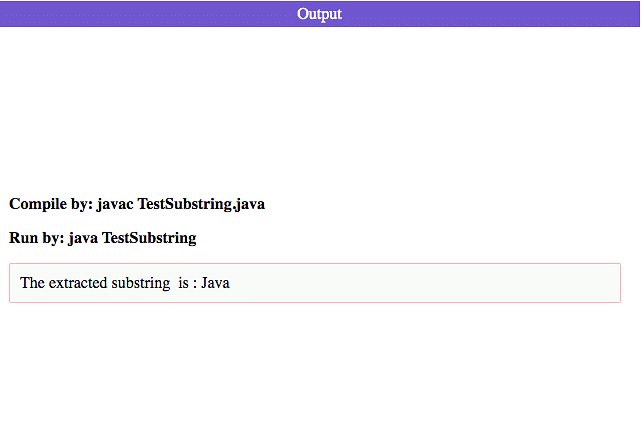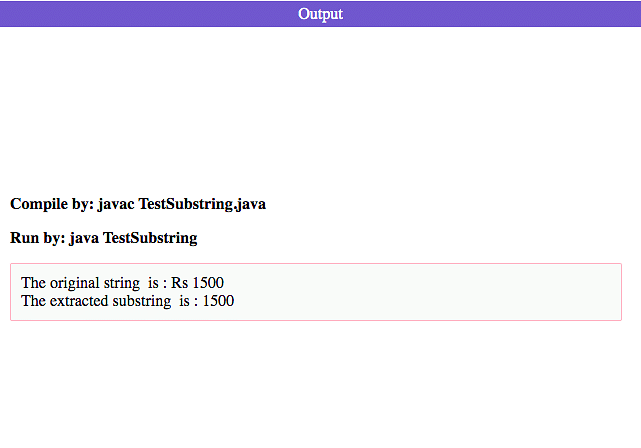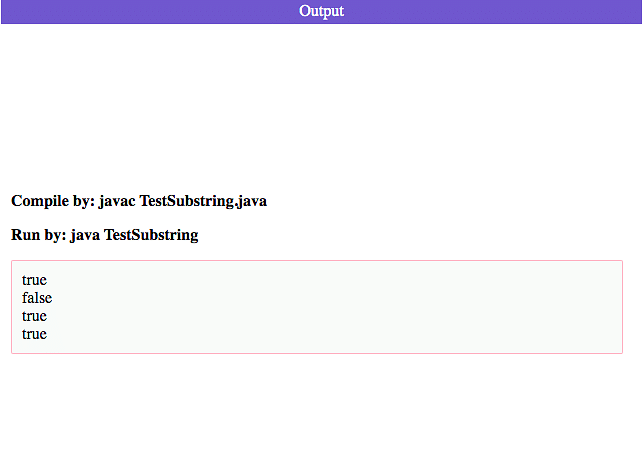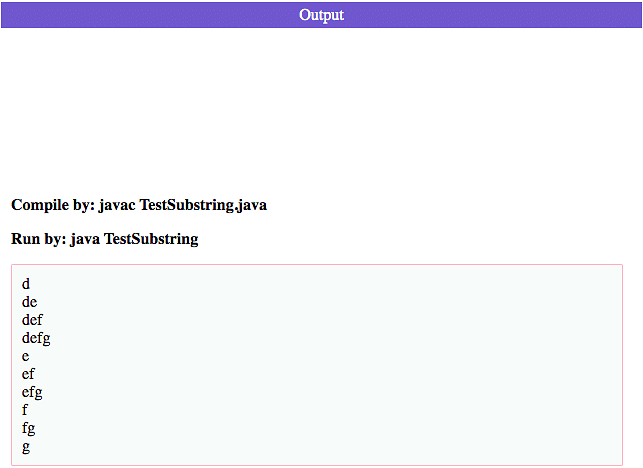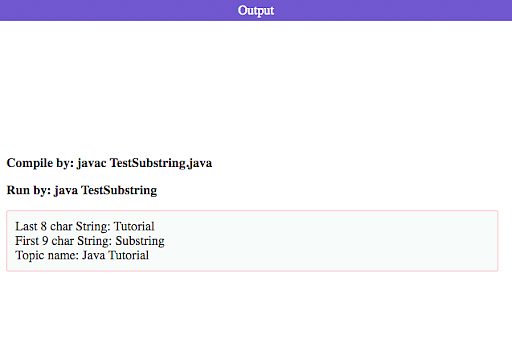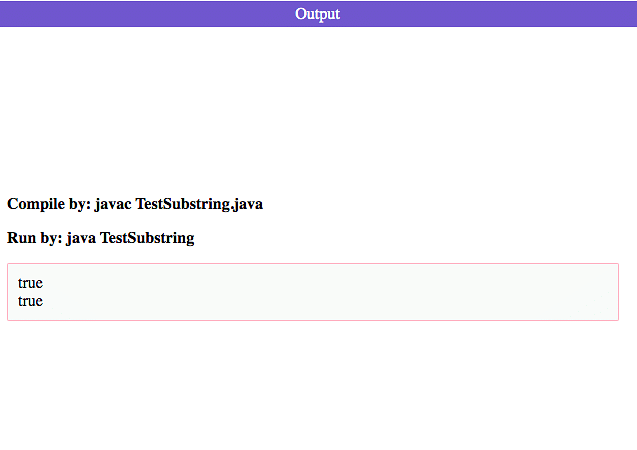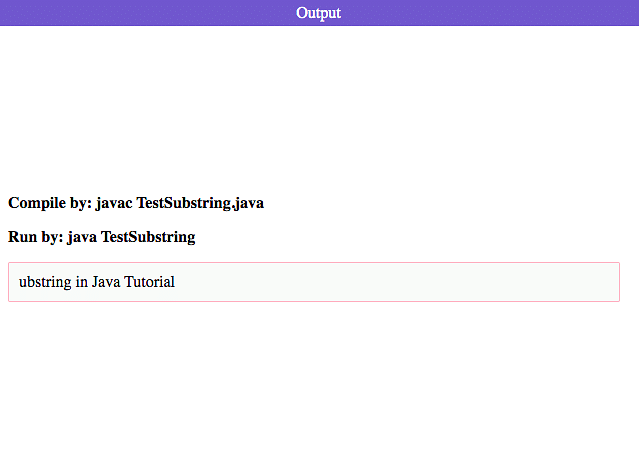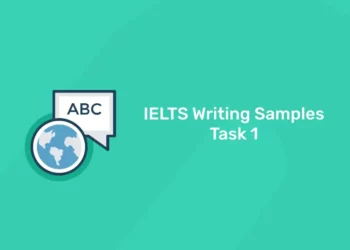Table of Contents
What is a Substring in Java?
1: What is the default value of a boolean in Java?
Substring in Java is a commonly used method of java.lang.String class that is used to create smaller strings from the bigger one. As strings are permanent in Java, the original string remains as it is, and the method returns a new string.
Syntax:
string.substring(int startIndex, int endIndex)
Note: Here, the endIndex is exclusive, but the startindex is inclusive, and the string is an object of the String class. We will see the use more in detail below.
The method produces an IndexOutofBoundsException if:
- endIndex is less than startIndex
- endIndex/StartIndex is greater than the string’s length
- endIndex/StartIndex is negative
Methods to Get a Substring
Substring in Java can be obtained from a given string object using one of the two variants:
1. Public String substring(int startIndex)
This method gives a new String object that includes the given string’s substring from a specified inclusive startIndex.
Syntax: public String substring(int startIndex)
Parameters: startIndex- the starting index (inclusive)
Returns: Specified substring
Example:
Code: public class TestSubstring {
public static void main(String args[])
{
// Initializing the String
String Str = new String(“Substring in Java Tutorial”);
// using substring() to extract substring
// should return: in Java Tutorial
System.out.print(“The extracted substring is : “);
System.out.println(Str.substring(10));
} }
Output:
2. Public String substring(int startIndex, int endIndex):
This method is used to return a new String object that includes a substring of the given string with their indexes lying between startIndex and endIndex. If the second argument is given, the substring begins with the element at the startIndex to endIndex -1.
Syntax : public String substring(int startIndex, int endIndex)
Parameters: startIndex: the starting index, inclusive
endIndex: the ending index, exclusive.
Return Value: Specified substring.
Example:
Code: public class TestSubstring {
public static void main(String args[])
{
// Initializing the String
String Str = new String(“Substring in Java Tutorial”);
// using substring() to extract substring
// should return Java
System.out.print(“The extracted substring is : “);
System.out.println(Str.substring(13, 17));
}
}
Output:
Use and Applications of Substring
1. The substring in Java method is used in many applications, including suffix and prefix extraction. For instance, if you want to extract the last name from a given name or extract the digits after the decimal point from a string containing digits both before and after the point. Here is the demonstration:
Code:
| // Java code to demonstrate the application of substring method
public class TestSubstring { public static void main(String args[]) { // Initializing the String String Str = new String(“Rs 1500”); // Printing the original string System.out.print(“The original string is : “); System.out.println(Str); // using substring method to extract substring // returns 1500 System.out.print(“The extracted substring is : “); System.out.println(Str.substring(3)); } } Output: |
Learn Coding in your Language! Enroll Here!
2. Check palindrome- We can use the substring in Java method to check if the given string is palindrome or not, i.e. if its read the same way from both ends. Here’s the demonstration:
Code- public class TestSubstring {
public static void main(String[] args) {
System.out.println(checkPalindrome(“adeda”));
System.out.println(checkPalindrome(“ABba”));
System.out.println(checkPalindrome(“1234321”));
System.out.println(checkPalindrome(“AAAA”));
}
private static boolean checkPalindrome(String s) {
if (s == null)
return false;
if (s.length() <= 1) {
return true;
}
String first = s.substring(0, 1);
String last = s.substring(s.length() – 1);
if (!first.equals(last))
return false;
else
return checkPalindrome(s.substring(1, s.length() – 1));
}
}
Output-
3. To get all the substrings of a string. Here is the code:
public class TestSubstring {
// Function to print all substrings of a string
public static void SubString(String s, int n)
{
for (int i = 0; i < n; i++)
for (int j = i+1; j <= n; j++)
System.out.println(s.substring(i, j));
}
public static void main(String[] args)
{
String s = “defg”;
SubString(s, s.length());
}
}
Output-
Explain the variants of the substring() method.
The two variants of the substring() method are:
- String substring()
- String substring(startIndex, endIndex)
Here is how two variants of the substring in the Java method can be used:
1. To get the first m and last n characters of a string.
Code:
public class TestSubstring {
public static void main(String[] args) {
String str = “Substring in Java Tutorial”;
System.out.println(“Last 8 char String: ” + str.substring(str.length() – 8));
System.out.println(“First 9 char String: ” + str.substring(0, 9));
System.out.println(“Topic name: ” + str.substring(13, 26));
}
}
Output:
2. It is interesting to note that substring in the Java method will return an empty string if the string’s length is passed as a parameter or if the same index is given as startIndex and endIndex. Here is an example:
Code: public class TestSubstring {
public static void main(String[] args) {
String quote = “Substring in Java Tutorial”;
String substr = quote.substring(quote.length()); System.out.println(substr.isEmpty());
//if begin = end
String sub = quote.substring(3,3);
System.out.println(sub.isEmpty());
}}
Output:
3. Deleting the first character : Strings in Java start at index 0, i.e., the first character is 0 indexed. If you need to remove the first character, use substring(1). This returns the substring without the initial character, which equals deleting the first character.
Code: public class TestSubstring {
public static void main(String[] args) {
String quote = “Substring in Java Tutorial”;
String substr = quote.substring(1);
System.out.println(substr);
}}
Output:
Grab the opportunity to learn Python with Entri! Click Here
Note: If the end Index is not specified then the substring in Java method returns all characters from startIndex.





